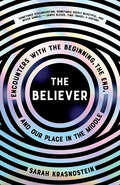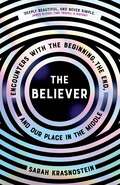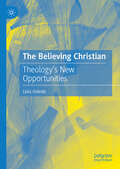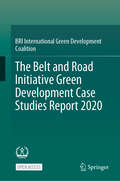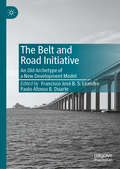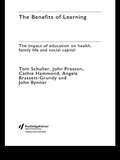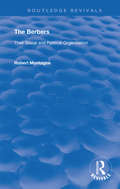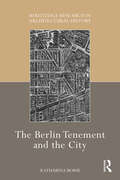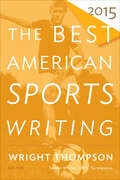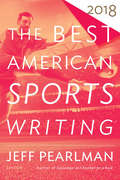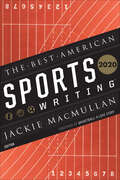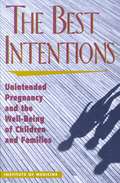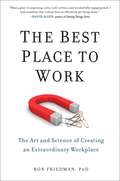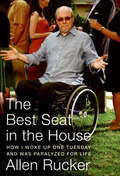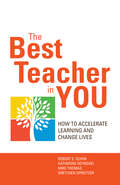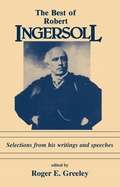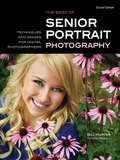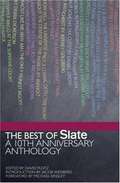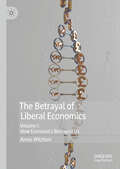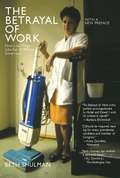- Table View
- List View
The Believer: Alien Encounters, Hard Science, and the Passion of John Mack
by Ralph BlumenthalThe Believer is the weird and chilling true story of Dr. John Mack. This eminent Harvard psychiatrist and Pulitzer Prize–winning biographer risked his career to investigate the phenomenon of human encounters with aliens and to give credibility to the stupefying tales shared by people who were utterly convinced they had happened.Nothing in Mack&’s four decades of psychiatry had prepared him for the otherworldly accounts of a cross section of humanity including young children who reported being taken against their wills by alien beings. Over the course of his career his interest in alien abduction grew from curiosity to wonder, ultimately developing into a limitless, unwavering passion.Based on exclusive access to Mack&’s archives, journals, and psychiatric notes and interviews with his family and closest associates, The Believer reveals the life and work of a man who explored the deepest of scientific conundrums and further leads us to the hidden dimensions and alternate realities that captivated Mack until the end of his life.
The Believer: Encounters with the Beginning, the End, and Our Place in the Middle
by Sarah Krasnostein“Deeply beautiful, and never simple.” — James Gleick, author of Time Travel: A History An unforgettable tour of the human condition that explores our universal need for belief to help us make sense of life, death, and everything in between. For Sarah Krasnostein it begins with a Mennonite choir on a subway platform, a fleeting moment of witness that sets her on a fascinating journey to discover why people need to believe in absolute truths and what happens when their beliefs crash into her own. Some of the people Krasnostein interviews believe in things many people do not: ghosts, UFOs, the literal creation of the universe in six days. Some believe in things most people would like to: dying with dignity and autonomy; facing up to our transgressions with truthfulness; living with integrity and compassion. By turns devastating and uplifting, and captured in snapshot-vivid detail, these six profiles — a death doula, a geologist who believes the world is six thousand years old, a lecturer in neurobiology who spends his weekends ghost hunting, the fiancé of a disappeared pilot and UFO enthusiasts, a woman incarcerated for killing her husband after suffering years of domestic violence, and Mennonite families in New York — will leave you convinced that the most ordinary-seeming people are often the most remarkable and that deep and abiding commonalities can be found within the greatest differences. Vivid, unconventional, entertaining, and full of wonder, The Believer interweaves these stories with compassion and empathy, culminating in an unforgettable tour of the human condition that cuts to the core of who we are as people, and what we’re doing on this earth.
The Believer: Encounters with the Beginning, the End, and our Place in the Middle
by Sarah KrasnosteinAn unforgettable tour of the human condition that explores our universal need for belief to help us make sense of life, death, and everything in between. <p><p> For Sarah Krasnostein it begins with a Mennonite choir performing on a subway platform, a fleeting moment of witness that sets her on a fascinating journey to discover why people need to believe in absolute truths and what happens when their beliefs crash into her own. Some of the people Krasnostein interviews believe in things many people do not: ghosts, UFOs, the literal creation of the universe in six days. Some believe in things most people would like to: dying with dignity and autonomy; facing up to our transgressions with truthfulness; living with integrity and compassion. <p><p> By turns devastating and uplifting, and captured in snapshot-vivid detail, these six profiles of a death doula, a geologist who believes the world is six thousand years old, a lecturer in neurobiology who spends his weekends ghost hunting, the fiancée of a disappeared pilot and UFO enthusiasts, a woman incarcerated for killing her husband after suffering years of domestic violence, and Mennonite families in New York will leave you convinced that the most ordinary-seeming people are often the most remarkable and that deep and abiding commonalities can be found within the greatest differences. <p><p> Vivid, unconventional, entertaining, and full of wonder, The Believer interweaves these stories with compassion and empathy, culminating in an unforgettable tour of the human condition that cuts to the core of who we are as people, and what we’re doing on this earth.
The Believing Christian: Theology’s New Opportunities
by Lluis OviedoThis book offers an updated version of the credibility treatise as part of a fundamental theology. Focusing on practical arguments that make Christian faith interesting and positive for improving the quality of one's life and relationships, it shows how the Christian faith is beneficial for the individual, the family and society as a whole. The book draws from recent literature on religious coping; religion and resilience; religion and well-being; religion and human flourishing to make the case for Christian faith as a good choice. This book also addresses the most difficult challenges facing the Christian faith in our time, such as a secularising environments, struggles with science, a troubled past, or simply the problem of making faith a convincing life style. It's an important read for scholars of theology, faith, and non-belief.
The Belt and Road Initiative Green Development Case Studies Report 2020
by BRI International Green DevelopmentThis is an Open Access book. In accordance with the 2030 Agenda for Sustainable Development, it showcases 17 projects under the framework of Belt & Road Initiative (BRI). These projects cover ninefields, namely, biodiversity and ecosystem, clean energy, clean water, sustainable transportation, solid waste treatment, sustainable consumption and production, green buildings, sustainable foodproduction and corporate social responsibility. Aiming at achieving green development, these projects, in their implementation, adhere to the concept of ecological civilization, combine China’s strict environmental protection systems and international standards, and take various measures of environmental protection based on the conditions of the local environment. These measures include joint efforts with local governments, businesses and communities, optimizating of design and construction plans, strict controling over different types of pollutants, and in situ conservation of species and ecosystems.The experience and practice of these 13 projects set an example for the latecomers.
The Belt and Road Initiative: An Old Archetype of a New Development Model
by Francisco José B. S. Leandro Paulo Afonso B. DuarteThis book is an analysis of the developments associated with the Belt and Road Initiative (B&RI) five years after Xi Jinping announced both the Silk Road Economic Belt (SREB) and the 21st Maritime Silk Road (21MSR). Together, these two dimensions constitute the B&RI, providing the so-called Chinese ‘project of the century’ with regional, inter-regional and global reach. This book aims at assessing the impact of the B&RI in all these dimensions and levels of influence. This is a current and promising theme, not only in the short and medium terms, but also within a broader timescale, reflecting Chinese strategic thinking itself, since Chinese philosophy and culture are oriented towards long-term and inter-generational perspectives. Likewise, both the title of this publication and the way it has been organized result from the empirical perception that China asserts a conservative attitude towards foreign affairs, redesigned in multiple dimensions, to create a perception of domestic unity and global prestige. In this vein of thought, the B&RI is already influencing and will continue to influence, directly or indirectly, the current economic and political order.
The Benefits of Learning: The Impact of Education on Health, Family Life and Social Capital
by John Preston John Bynner Tom Schuller Cathie Hammond Angela Brassett-GrundyHow do education and learning really impact on people's lives?The Benefits of Learning is a detailed, systematic and vivid account of the impact of formal and informal education on people's lives. Based on extended interviews with adults of all ages, it shows how learning affects their health, family lives and participation in civic life, revealing the downsides of education as well as the benefits. At a time when education is in danger of being narrowly regarded as an instrument of economic growth, this study covers:* the interaction between learning and people's physical and psychological well-being* the way learning impacts on family life and communication between generations* the effect on people's ability and motivation to take part in civic and community life.Packed with detail from adults' own accounts of their lives, the book reveals how learning enables people to sustain themselves and their communities in the face of daily stresses and strains, as well as sometimes transforming their lives. The book opens up new avenues for debate. It is a valuable resource for education researchers and of particular interest to education policy makers, adult education practitioners, health educators and postgraduate students in education.
The Berbers: Their Social and Political Organisation (Routledge Revivals)
by Robert MontagneOriginally published in 1931 and re-editioned in 1973, this book presents Robert Montagues findings about the Berber world, providing a major contribution to the understanding of Islam and of Africa. Students of pre-industrial civilisations and of tribal societies alike, as well as anyone concerned with the Middle East or Africa, will welcome this text.
The Berlin Tenement and the City (Routledge Research in Architectural History)
by Katharina BorsiThe Berlin Tenement and the City describes the development of the Berlin tenement from 1860 to 1914, showing how it became both Berlin’s standard housing type and its principal urban component – the city’s ubiquitous typology. In contrast to earlier historical categorizations of the tenement as a ‘rental barrack,’ here it is described as an evolving typology that dynamically responded to the demands of the city and urban reform.In this dynamic understanding of architecture, the tenement is the protagonist of the actual unfolding of the city, its growth and densification, as well as its spatial and social differentiation. Charting the evolution of the productive tenement into a morphology combining living and manufacturing and the rise of tenements increasingly differentiated according to class traces their contribution to the evolution and generalization of norms of housing and domesticity.This book is essential reading for scholars, students, architects and urbanists interested in Berlin or the history of housing and the city.
The Best American Sports Writing 2015 (The Best American Series)
by Wright ThompsonFor twenty-five years, The Best American Sports Writing has built a solid reputation by showcasing the greatest sports journalism of the past year, culled from hundreds of national, regional, and specialty print and digital publications. Wright Thompson, many times included in this volume over the years, takes his turn at the helm by curating this exceptional collection. The only shared trait among these diverse pieces is the extraordinarily high caliber of writing, but collectively they tap into the pure passion that can only come from sports. And for all aspiring sports writers, says Thompson, &“these selections are both road map and compass.&” The Best American Sports Writing 2015 includesDon Van Natta Jr., Chris Ballard, Katie Baker, Christopher Beam, Wells Tower, Seth Wickersham, Ariel Levyand others WRIGHT THOMPSON, guest editor, started his sports writing career as a student at the University of Missouri, where he covered sports for the Columbia Missourian. He interned at the Times-Picayune in New Orleans and worked as the LSU beat writer. He then moved to the Kansas City Star, where he covered a wide variety of sports. In 2006 he joined ESPN.com and ESPN: The Magazine as a senior writer. He lives in Oxford, Mississippi. GLENN STOUT, series editor for The Best American Sports Writing since its inception, is the author of Young Woman and the Sea and Fenway 1912. He serves as the long-form editor for SB Nation and lives in Alburgh, Vermont.
The Best American Sports Writing 2017
by Glenn Stout Howard Bryant“Excellent . . . A no-brainer pickup for the sports collection.” —Booklist For over twenty-five years, The Best American Sports Writing has built a solid reputation by showcasing the greatest sports journalism of the previous year, culled from hundreds of national, regional, and specialty print and digital publications. Each year, the series editor and guest editor curate a truly exceptional collection. The only shared traits among all these diverse styles, voices, and stories are the extraordinarily high caliber of writing and the pure passion they tap into that can only come from sports.
The Best American Sports Writing 2018 (The Best American Series ®)
by Jeff Pearlman Glenn StoutFor more than twenty-five years, The Best American Sports Writing has built a solid reputation by showcasing the greatest sports journalism of the previous year, culled from hundreds of national, regional, and specialty print and digital publications. Each year, the series editor and guest editor curate a truly exceptional collection. The only shared traits among all these diverse styles, voices, and stories are the extraordinarily high caliber of writing, and the pure passion they tap into that can only come from sports.
The Best American Sports Writing 2019 (The Best American Series)
by Charles P. PierceThe latest addition to the acclaimed series showcasing the best sports writing from the past year For over twenty-five years, The Best American Sports Writing has built a solid reputation by showcasing the greatest sports journalism of the previous year, culled from hundreds of national, regional, and specialty print and digital publications. Each year, the series editor and guest editor curates a truly exceptional collection. The only shared traits among all these diverse styles, voices, and stories are the extraordinarily high caliber of writing, and the pure passion they tap into that can only come from sports.
The Best American Sports Writing 2020 (The Best American Series)
by Jackie MacMullan, Glenn StoutThe latest addition to the acclaimed series showcasing the best sports writing from the past year.For over twenty-five years, The Best American Sports Writing has built a solid reputation by showcasing the greatest sports journalism of the previous year, culled from hundreds of national, regional, and specialty print and digital publications. Each year, the series editor and guest editor curate a truly exceptional collection. The only shared traits among all these diverse styles, voices, and stories are the extraordinarily high caliber of writing, and the pure passion they tap into that can only come from sports.
The Best Intentions: Unintended Pregnancy and the Well-Being of Children and Families
by Committee on Unintended PregnancyExperts estimate that nearly 60 percent of all U.S. pregnancies--and 81 percent of pregnancies among adolescents--are unintended. Yet the topic of preventing these unintended pregnancies has long been treated gingerly because of personal sensitivities and public controversies, especially the angry debate over abortion. Additionally, child welfare advocates long have overlooked the connection between pregnancy planning and the improved well-being of families and communities that results when children are wanted.Now, current issues--health care and welfare reform, and the new international focus on population--are drawing attention to the consequences of unintended pregnancy. In this climate The Best Intentions offers a timely exploration of family planning issues from a distinguished panel of experts.This committee sheds much-needed light on the questions and controversies surrounding unintended pregnancy. The book offers specific recommendations to put the United States on par with other developed nations in terms of contraceptive attitudes and policies, and it considers the effectiveness of over 20 pregnancy prevention programs.The Best Intentions explores problematic definitions--"unintended" versus "unwanted" versus "mistimed"--and presents data on pregnancy rates and trends. The book also summarizes the health and social consequences of unintended pregnancies, for both men and women, and for the children they bear.Why does unintended pregnancy occur? In discussions of "reasons behind the rates," the book examines Americans' ambivalence about sexuality and the many other social, cultural, religious, and economic factors that affect our approach to contraception. The committee explores the complicated web of peer pressure, life aspirations, and notions of romance that shape an individual's decisions about sex, contraception, and pregnancy. And the book looks at such practical issues as the attitudes of doctors toward birth control and the place of contraception in both health insurance and "managed care."The Best Intentions offers frank discussion, synthesis of data, and policy recommendations on one of today's most sensitive social topics. This book will be important to policymakers, health and social service personnel, foundation executives, opinion leaders, researchers, and concerned individuals. May
The Best Place to Work: The Art and Science of Creating an Extraordinary Workplace
by Ron FriedmanFor readers of Malcolm Gladwell, Daniel Pink, and Freakonomics, comes a captivating and surprising journey through the science of workplace excellence. Why do successful companies reward failure? What can casinos teach us about building a happy workplace? How do you design an office that enhances both attention to detail and creativity? In The Best Place to Work, award-winning psychologist Ron Friedman, Ph.D. uses the latest research from the fields of motivation, creativity, behavioral economics, neuroscience, and management to reveal what really makes us successful at work. Combining powerful stories with cutting edge findings, Friedman shows leaders at every level how they can use scientifically-proven techniques to promote smarter thinking, greater innovation, and stronger performance. Among the many surprising insights, Friedman explains how learning to think like a hostage negotiator can help you diffuse a workplace argument, why placing a fish bowl near your desk can elevate your thinking, and how incorporating strategic distractions into your schedule can help you reach smarter decisions. Along the way, the book introduces the inventor who created the cubicle, the president who brought down the world's most dangerous criminal, and the teenager who single-handedly transformed professional tennis--vivid stories that offer unexpected revelations on achieving workplace excellence. Brimming with counterintuitive insights and actionable recommendations, The Best Place to Work offers employees and executives alike game-changing advice for working smarter and turning any organization--regardless of its size, budgets, or ambitions--into an extraordinary workplace.
The Best Seat in the House: How I Woke Up One Tuesday and Was Paralyzed for Life
by Allen RuckerLike the day Elvis died or O.J. was acquitted, the Tuesday you wake up paralyzed is not a day you soon forget. For writer Allen Rucker—baby boomer, husband, father of two, aging Hollywood also-ran—life started over that Tuesday when, at the age of fifty-one, he was struck by a rare disorder—transverse myelitis—that left him paralyzed from the waist down. Why him? Was he being punished? Was it his stressful life? His frustrating career? Telling too many Christopher Reeve jokes? Dazed and paralyzed, he was forced to reevaluate everything, from the simplest bodily functions to the mysteries of the universe. In a style that is at once funny and moving, The Best Seat in the House offers an unpretentious and unapologetic account of learning to live with paralysis. Without trivializing his situation, and without sermons or clichés, Rucker invites all readers, whether disabled or not, to identify with him for better or for worse. This remarkably comic and heartfelt book speaks to the fragility of life and to the resilience and adaptability of a single, ordinary human being. Lucky for us, this human being has a sense of humor. At first, it may not look like the best seat in the house, but read on. You might be surprised.
The Best Teacher in You: How to Accelerate Learning and Change Lives
by Robert E. Quinn Mike Thomas Katherine Heynoski Gretchen M. SpreitzerWhat does teaching look like at its very best? How are great teachers able to ignite a love of learning and change students’ lives? In this book you’ll learn from seven remarkable teachers who stretch beyond the conventional foundations of good teaching to transform their classrooms into exciting, dynamic places where teachers and students cocreate the learning experience. Based on six years of extensive work, the book outlines a framework that identifies four dimensions of effective teaching and learning that are integrated in these highly effective teachers’ classrooms—and that all teachers can use to recognize and release the potential in themselves and their students.
The Best Wisconsin Sports Arguments
by Andy KendeighAn essential sports reference for Packers, Badgers, Brewers, and Bucks fans! Brand-new to the popular Best Sports Arguments series, The Best Wisconsin Sports Arguments looks at the great debates from the most-loved sports of the state of Wisconsin, including: The great Favre debate: who's right and who's wrong? What's the greatest moment in Wisconsin sports history? Who's the bigger Badger rival-Iowa or Minnesota? Better tradition-"Jump Around" or the sausage race? Written by veteran Wisconsin sports personality Andy Kendeigh, The Best Wisconsin Sports Arguments covers football, baseball, basketball, hockey, and more. Every question a Wisconsin sports fan wants to explore is here, sure to spark controversy and debate.
The Best of Robert Ingersoll: Selections from His Writings and Speeches
by Robert G. Ingersoll Roger E. GreeleySelected quotations and a few speeches of the noted 19th century American orator, freethinker and agnostic, Robert Ingersoll. His pleas for civil rights, the rights of women and children, responsible and responsive government, and individual freedom of conscience and religious belief have placed him in the vanguard of enlightened thinkers. Today the legacy of Robert Ingersoll, prophet and pioneer, merits the attention of anyone who espouses humane, liberal, rational, or agnostic opinions.
The Best of Senior Portrait Photography
by Bill HurterFrom yearbook advertisements, postcard mailings, and promotions to web site development and digital graduation announcements, every corner of the teen and senior portrait market is covered in this book of advice from the experts. The artistry of top senior portrait experts, including Fuzzy Duenkel, Jeff Smith, Ellie Vayo, Richard Pahl, Ralph Romaguera, and Deborah Lynn Ferro, reveals the artistic, photographic, and marketing techniques that have propelled them to the top of their field. Advice on posing, communication and expression during sessions, studio lighting, outdoor lighting, working with different client personalities, pricing, and proofing is provided.
The Best of Slate: A 10th Anniversary Anthology
by David PlotzIn the last decade, Slate has gone from fairly well-kept secret to near-household name, with a monthly audience that has risen from the thousands to the millions. Yet our readers persist in regarding us as a great little restaurant that hasn't yet been discovered.
The Best of the Best: Becoming Elite at an American Boarding School
by Rubén A. Gaztambide-FernándezFor two years, Rubén Gaztambide-Fernández shared the life of what he calls the “Weston School,” an elite New England boarding school. He sat in on classes, ate meals in the dining halls, cheered at sporting events, hung out in dorms while students baked cookies or celebrated birthdays. And through it all, observing the experiences of a diverse group of students, conducting interviews and focus groups, he developed a nuanced portrait of how these students make sense of their extraordinary good fortune in attending the school. Vividly describing the pastoral landscape and graceful buildings, the rich variety of classes and activities, and the official and unofficial rules that define the school, The Best of the Best reveals a small world of deeply ambitious, intensely pressured students. Some are on scholarship, others have never met a public school student, but all feel they have earned their place as a “Westonian” by being smart and working hard. Weston is a family, they declare, with a niche for everyone, but the hierarchy of coolness—the way in which class, race, sexism, and good looks can determine one’s place—is well known. For Gaztambide-Fernández, Weston is daunting yet strikingly bucolic, inspiring but frustratingly incurious, and sometimes—especially for young women—a gilded cage for a gilded age. “Would you send your daughter here?” one girl asks him, and seeing his hesitation asks, “Because you love her?”
The Betrayal of Liberal Economics: Volume I: How Economics Betrayed Us
by Amos WitztumThe presumed sovereignty of individuals and the facilitating powers of the markets have generated a universal and ethically neutral conception of both social and economic organisation. This ground-breaking text re-examines the purpose of society and the role of economics in it, arguing that the absence of a beneficial natural order calls for the role of the collective in social and economic life to be revisited. Drawing on some key figures marking milestones in the evolution of social and economic thinking, the author offers a critique of mainstream economics as a way of thinking and as a provider of guiding principles for economic and social organisation. Volume I introduces the reader to the emergence of natural order; considers the internal logic of economics and how it managed to be so persuasive in its recommendation for competitive interactions to govern all aspects of social life in all societies and across them; demonstrates that the economic conception of an order which solves society’s economic problem is, in fact, an impossibility that turns the natural phenomenon of markets into a problem rather than an ideal; and, addresses the other apparent appeal of markets: their association with the ideas of freedom and justice. This is a bold and foundational new work that offers an original and innovative perspective on economics and its challenges, addressing core areas such as behavioural economics, evolutionary game theory and links between social sciences (anthropology, philosophy) and neurosciences.”
The Betrayal of Work
by Beth ShulmanFollowing its publication in hardcover, the critically acclaimed Betrayal of Work became one of the most influential policy books about economic life in America; it was discussed in the pages of Newsweek, Business Week, Fortune, the Washington Post, Newsday, and USA Today, as well as in public policy journals and in broadcast interviews, including a one-on-one with Bill Moyers on PBS's NOW. The American Prospect's James K. Galbraith's praise was typical: "Shulman's slim and graceful book is a model combination of compelling portraiture, common sense, and understated conviction."Beth Shulman's powerfully argued book offers a full program to address the injustice faced by the 30 million Americans who work full time but do not make a living wage. As the influential Harvard Business School newsletter put it, Shulman "specifically outlines how structural changes in the economy may be achieved, thus expanding opportunities for all Americans." This edition includes a new afterword that intervenes in the post-election debate by arguing that low-wage work is an urgent moral issue of our time.

